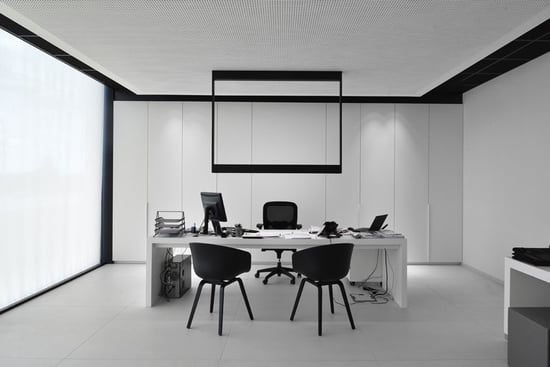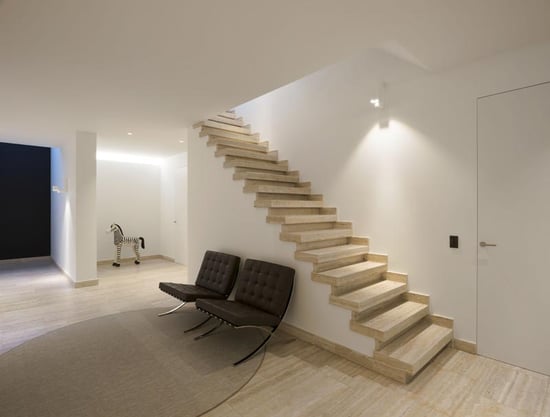Today, we do not only use lighting to expel darkness. The design and atmosphere aspects have become more and more important. The lighting design must therefore not only be functional, but should also be functionally beautiful. An original design for a lamp is impressive, but it's not all there is. Light (or more accurately stated: the color temperature of light) has a big effect on your interior and the atmosphere in the room. It not only determines how a space looks, but also impacts the way people feel when they’re in said room. This feeling is heavily determined by the placement of warm or cold light.
The color temperature of light
Light is named by two items: the color temperature and the color display. The color temperature of light (CCT - correlated color temperature) is displayed in degrees Kelvin (K). The temperature of light used indoors can range from 2000K to about 6500K. The higher the color temperature, the colder the light.
At 1200K we therefore speak of warm light. This is the color temperature of a candle. At 5600K we speak of cold light. 5600K equals daylight. Warm light has a red to yellowish appearance, cold light has a white to bluish appearance.
Light is also determined by the color display. This value measures how well we can observe colors under a certain kind of light. This is used in a color rendering index (or CRI), with a scale of 1 to 100 Ra. 100 Ra stands for perfect light, in this case daylight. 80 Ra is therefore the norm for most environments; In stores where colors should match daylight, like paint or clothing stores, the norm is 90 Ra.

Warm light or cold light?
Is it better to use warm light now? Or are you better off choosing cold light? That depends on where you need it. Warm white light around 2700K is usually used at home. These are usually glow, halogen or energy-saving lamps. The yellowish glow creates a warm, cozy atmosphere. The color is soothing.
But that’s not ideal if you have to be productive, like at work. Warm lighting in the office is cozy, but creates too large contrasts in space. Your eyes must work hard to adapt to this, which is very tiring. Therefore, it’s better to place lighting with higher color temperatures (3000 - 4000K) or cold white light (more than 5000K) in workstations like a desk, office or restaurant kitchens.
When looking for lighting for an art gallery, it is best to choose lamps with a color temperature that is closest to daylight. The lighting will then be very functional and simple and will create a sober and open atmosphere.

The effects of light
Not only the function of space determines the choice between hot and cold light, but also the emotion of the people living, working or passing in or through it. Thus, warm light creates a romantic atmosphere, because it recreates the same elements as candlelight. On the other hand, using cold light, which is closest to daylight, makes people happier and more energized. To combine both types, it’s possible to use lights with a dimmer. This way, you can determine the atmosphere by dimming the lights in the evenings and give more power during the daytime.

The design of a lighting plan should always be done in function of the atmosphere you wish to create in a space. What elements in the space do you want to accentuate and in what way? There are so many factors to consider to determine whether it’s best to opt for warm light or cold light.
controlling the light
Tunable White
Allows the user access to the full range of white light from warm tones (around 1650K), to neutral, and cool white color (around 8000K). Tunable light plays a roll in regulating the Circadian Rhythm and regulating the body’s biological clock enhancing energy, alertness and overall mood. This natural rhythm produces lights warmer in the morning and cooler towards the afternoon. In a more targeted application it can also aid in setting the desired behavior or mood by specifically cooling or warming a space in counterpoint to the circadian rhythm ; its inhabitants can be calmed such as children in a classroom with warm light, or alertness can be increased, such as in an office with cool light in the afternoon. Applications that would benefit most would be classrooms, offices, and retail locations and residential.
Dim-to-Warm
These products, also referred to as warm dim, blackbody dimming or incandescent-like dimming, mimic incandescent or halogen dimming performance. With a starting color temperature of 3000K at full output with it warming to yellow or red as the output is reduced, down to 1800K (the color of candlelight). Applications are endless, but most often used in restaurants, hotel lobbies, theaters, or residential
Full color tunable
Also referred to as RGB, RGBA, RGBW, spectrally tunable, or color changing, can be varied in output to create a mixture of light that is white, a tint of white, or a fully saturated hue. The unique advantage of this type of color-tuning is the ability to move the color point off the white light spectrum toward light with a distinct color for branding purposes or entertainment. It Also has the ability to match the intensity and look of any other type light source. Suitable in applications such as museums, corporate offices, restaurants or theatres.

